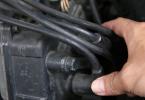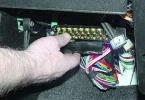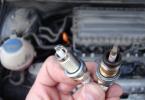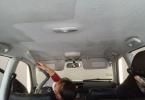Anyone who at least once tried to touch the car, knows perfectly well why it is needed. If you click, and then let go, then the car will go. If I did not go - it means that you have fallen incorrectly on it. Well, and if it is serious, the clutch pedal is one of the vehicle management bodies, and in many cases it can be judged by the state of the car.
Why is the extra pedal
The clutch is an element of a car design that takes part in the transmission of the moment to the wheels from the engine and allowing this transmission to break briefly, which is performed by the driver when it clicks on the clutch pedal. Considering the issue of its purpose and role in driving a car, it is impossible, at least briefly, do not touch the device such a mechanism.
However, before dealing with the design of the control mechanism, it is required to make a reservation that it is necessary to use it quite carefully. No wonder when driving the car, the left foot does not apply to the pedal, but should lie on the place specifically provided for it. This is due to the fact that when the engine is turned off from the wheels, the possibility of control is sharply reduced, the machine is moving only by inertia. Especially dangerous such movement on a wet or slippery road.
In such cases, the same braking must be performed without clutch. Otherwise, a car drift is possible with unpredictable consequences, especially for beginners who are not ready for such a change in the behavior of the car.
It is best to be guided by one general rule - when moving on a flat road in the absence of the need to switch the transmission to control the car, using only gas and brake. The same applies to the movement from the slide, in this case it is impossible to drive riding or when the engine is turned off from wheels.
The engine should always be ready to convey, and the wheels get the required torque. Only then you keep the full opportunity to control the behavior of the car. Therefore, to use the clutch pedal is necessary only if necessary, only in cases where it is impossible not to do without it, as when switching gear or the beginning of the movement. Bearing in mind that it is necessary to do it carefully and carefully, since in the process of switching gear, there is a sharp dynamic load on various nodes of the machine.
Like clutch arranged
In the most general form, its design is shown in the figure
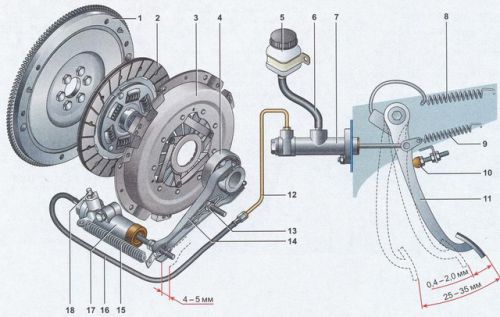
Without going into details, it is necessary to note the presence of such nodes as the flywheel (1), which is also part of the engine, as well as the slave disk (2), the clutch baskets (3) and, of course, the drive that includes almost all other parts in including clutch pedal (11). Here it is only necessary to say that a rather enlarged and simplified statement of the design is given, in no way, however, which is not preventing an understanding of its value, the role of this mechanism by car.
To correctly understand the design, it is necessary to clarify that the drive connecting the clutch pedal with the mechanism itself may be in its execution:
- hydraulic, as shown in the figure below;
- mechanical;
- pneumatic;
- electric, etc.
Why it is needed - break the transfer of moment from the engine
Everything is very simple. Depending on the conditions of movement on the wheels, various torque is supplied. Its value can be changed using a gearbox by choosing the desired transmission. However, when gears in the box are in engagement and spin, it is impossible to switch the transmission. To try, of course, it is possible, but the result will be the replacement of the destroyed PPC.
To avoid this for any ride modes, as well as at the beginning of the movement, adhesion is used in the car design. In the case of clicking on it, the connection between the checkpoint and the engine is broken, as a result of which it is possible to quietly switch the transmission or move from the place.
On some faults
From the above figure it can be seen that in addition to the nodes of the adhesion itself, others are also involved in its work. It is not necessary, probably, it is not to say that only their good condition, as well as other elements of the drive connecting the clutch pedal with a basket, ensures safe conditions of movement. As an example, you can consider various possible situations in which the associated faults can manifest.
Free pedals
One of the parameters characterizing the health and correctness of the adjustment of the entire system is the free course of clutch pedal. This is the name of the distance that the clutch pedal is fluent in its trigger. A free course appears due to the presence of gaps in separate nodes and drive elements. It is clearly shown in the figure above and should not exceed thirty-five millimeters. It feels the gap as the movement of the pedal of the clutch without effort when pressed on it.
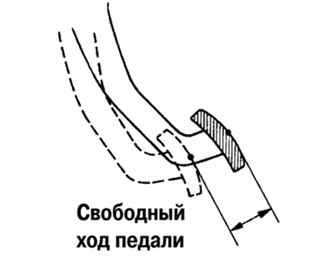
In other words, at first, when pressed on the pedal, it moves freely, and then the resistance to movement begins to be felt. This gap is a movement without effort and is called a free move. Its too important indicates a significant wear of the details or the need for adjustment. If this is not executed, then there may be problems with the inclusion or transmission.
Falling the clutch pedal
When they click on the pedal, it takes down without any effort down without returning to normal position. The reasons for this may be several, here are some of the possible:
- the clutch cable in place of the seal of its tip broke (in the case of a mechanical drive). Such a defect is eliminated by the replacement of the cable, and it is necessary to conduct it in a service center or workshop;
- detected or burst the return spring (9). In cases where the spring flew, then after putting it into place, the defect - the clutch pedal failed, will be eliminated. Otherwise, it is necessary to get again to the workshop.
- the plug of inclusion (14) was broken because of which the clutch pedal failed. It is clear that in this case the repair is possible in a garage or workshop;
- i got the air into the hydraulic system. Then it is necessary to pump the drive to remove the air.
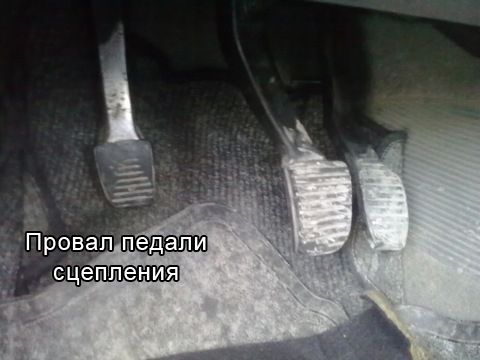
You can get to the car service in principle, using this technique. Turn off the engine, turn on the transmission (first or second), turn the key, start the motor and at the same time add gas, while the car will immediately start moving. That's how to go, without switching the transfer and not stopping.
Castle clutch pedal when pressing
This phenomenon also has several reasons. It may be caused by a defect, for example, the same fork (14) and is eliminated by its replacement. Wearing other drive elements can also cause clutch pedal creak. To prevent it in this case, it is necessary to lubricate all possible locations of the symbol (articulation of parts) and replace worn.
The reason that causes the clutch pedal creap can be directly some of the springs used or the clutch cable itself. It is necessary to relate to such a phenomenon very carefully, the creap pedal creak must be perceived as a precursor of the failure of one of the drive parts, for example, a cliff of the cable.
Knock when the clutch pedal
It is definitely difficult to call the reason for this phenomenon. The knock when the clutch pedal is released can be caused by both the wear of the details of the clutch itself and the transmission of transmission to the checkpoint. If this is connected with the wear of the clutch details, then it is necessary to conduct its diagnostics, although in most cases everything can be replaced by the recommendation of the replacement, at least the basket, although it is not necessary that after this knock when the clutch pedal is released.
You should not forget that when the pedal is released, the car begins to move, and it is quite possible that the occurrence of a knock on the clutch pedal is not connected with this. The source of it can be completely different nodes, for example, suspension elements.
Vibrates clutch pedal
In this case, most likely, the reason for the appearance of vibration will be the wear or deformation of the individual parts of the clutch mechanism. This is eliminated only by replacement.
Noise when the clutch pedal
Such a defect is classified unambiguously. The noise when the clutch pedal is released is caused by wear or damage to the release bearing. The reason for this can be both bearing wear and incorrect ride manner. It should be reminded here that when moving the car, the left foot should not touch the pedal. If this is not executed, then the described defect is possible. In addition, the reason may be the beginning of the movement on high engine speeds.
In addition, the clutch pedal turns on the connection of the engine and the transmission, it can serve as a kind of indicator of its technical condition, signaling about the likely faults or a reference approximation in the near future. An important meaning also also needs that it is necessary to competent and correct use of the capabilities provided by these elements of the car's design.
